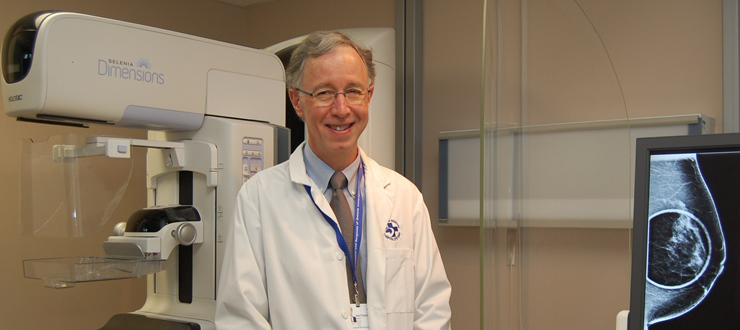
Dr. James Watters said the Breast Cancer Community of Practice allows a diverse set of professionals to bring their ideas and concerns to the table, discuss them as equals, seek guidance and work towards making patient care consistent across the region.
Today, patients preparing for surgery to remove breast cancer get MRIs if they meet particular criteria. But four years ago, getting the test depended on where the patient was being treated – it wasn’t consistent, and that was frustrating for patients and health-care providers in the Champlain region.
The issue was taken to the Breast Cancer Community of Practice (CoP) and changes began to happen, illustrating just how effective Ottawa’s unique Community of Practice model can be.
MRIs (magnetic resonance imaging) offer a very sensitive way of looking at breast tissue to identify cancer. Many health-care providers felt at the time that routine MRIs before surgery would be useful to gain a clearer understanding of the cancer and look for other areas of cancer, leading to better surgeries, said Dr. James Watters, Medical Director of The Ottawa Hospital’s Women’s Breast Health Centre.
It wasn’t a universally held view, said Dr. Watters, but it was a reasonable view supported by many in the region.
The discussion was brought to the Breast Cancer CoP. Now over a decade old, the CoP is a collective of health-care professionals that includes surgeons, oncologists, radiologists, administrators and nurses. It aims to come to a consensus on specific issues so that it can guide and standardize practices across the region.
“As a group, we came to the view that this was something we wanted to do. Quite quickly, it became the case that almost every patient would have a pre-operative breast MRI,” said Dr. Watters.
Over the next year, new evidence from The Ottawa Hospital and published studies failed to show the expected benefits and began to show unintended consequences: it was taking longer to get patients to surgery and more uncertain results needed to be verified through biopsies.
The CoP decided that the trade-off and cost didn’t make sense and, after discussion, decided to offer MRIs selectively, where they would give the most benefit to patients. The number of patients receiving MRIs dropped quickly.
“It gave everyone a certain confidence in the group, and showed that we would continue to review and seek new evidence, and then decide collectively to change our practice,” said Dr. Watters. “It was impressive how rapidly the CoP could change practice in the region.”
Currently, the group is working to provide regional guidance for breast reconstruction, consider the benefits of chemotherapy and radiation before surgery rather than after, and improve how patients get information.
“The breast CoP has been a model for regional integration and innovation,” said Dr. Michael Fung-Kee-Fung, who developed the Ottawa CoP model. “Their work has had an amazing, positive impact on quality of care and cost effectiveness.”
The key to CoP success, said Dr. Watters, is that it allows a diverse set of professionals to bring their ideas and concerns to the table, discuss them as equals, and seek guidance so that patient care is consistent across the region.
“A lot of what we’ve accomplished is bringing different worlds together.”

Support patient care and research at
The Ottawa Hospital


 To reset, hold the Ctrl key, then press 0.
To reset, hold the Ctrl key, then press 0.